Genus Camponotus subgenus Myrmespera
| The Ants of
Africa Genus Camponotus subgenus Myrmespera |
|
| Genus Camponotus |
Subgenus definition - Santschi (1926b: 247; Santschi, 1926c:
604). Santschi's (1926b) subgenus description is at ![]() . He separated the
members as intermediate between Camponotus s.s and Myrmopsamma
on the basis of there being no anterior fringe of hairs on the clypeus;
the only clypeal hairs being laterally, as with Camponotus s.s. In
common with Myrmopsamma, however, the apex of the mandibles is
quite oblique and with five distinct teeth, the apical being notably
the longest. In contrast Myrmoturba (now junior synonym of Tanaemyrmex)
have a lobed clypeus.
. He separated the
members as intermediate between Camponotus s.s and Myrmopsamma
on the basis of there being no anterior fringe of hairs on the clypeus;
the only clypeal hairs being laterally, as with Camponotus s.s. In
common with Myrmopsamma, however, the apex of the mandibles is
quite oblique and with five distinct teeth, the apical being notably
the longest. In contrast Myrmoturba (now junior synonym of Tanaemyrmex)
have a lobed clypeus.
![]() All from southern and eastern
Africa. My feeling is that this is a
collection of two distinct groups - one with a fairly typical (major) Camponotus
head in full face view, i.e narrower anteriorly and a slightly concave
posterior margin; the other with a quadrate, parallel-sided head, with
straight posterior margin and rounded postero-lateral margins, also
large eyes set well back.
All from southern and eastern
Africa. My feeling is that this is a
collection of two distinct groups - one with a fairly typical (major) Camponotus
head in full face view, i.e narrower anteriorly and a slightly concave
posterior margin; the other with a quadrate, parallel-sided head, with
straight posterior margin and rounded postero-lateral margins, also
large eyes set well back.
Tentative key to workers
| ¤ | Queen only - image on species page |
South Africa - trifasciatus |
| 1 | Propodeum highly convex both across and along, so near hemispherical | 2 |
| -- | Propodeum shallowly convex both across and along, arcuate transition from dorsum to declivity | 4 |
| 2 |  TL
major 6.0-6.2 mm, minor 3.5-4.0 mm; clypeus not carinate with feebly
arcuate anterior margin; sparse yellowish erect hairs; slightly
shining, anterior 0.8 of head dull due to microscopic transverse
rugulae; black, tarsi and mandibles more brown TL
major 6.0-6.2 mm, minor 3.5-4.0 mm; clypeus not carinate with feebly
arcuate anterior margin; sparse yellowish erect hairs; slightly
shining, anterior 0.8 of head dull due to microscopic transverse
rugulae; black, tarsi and mandibles more brownI have (2013) transferred this to the subgenus Myrmonesites |
South Africa - reevei |
| -- | Colour variably ochreous | 3 |
| 3 |  TL
major 7.2-8.5; like emarginatus but larger & darker,
mostly dark ochreous; head narrower anteriorly and sides more convex;
scapes falling short of occiput; mandibles shiny, very strongly
punctured; propodeum dorsum convex across and lengthwise, joining
equally long declivity in very wide obtuse angle; petiole scale convex
anteriorly, posterior flat, dorsal edge convex transversely and
trenchant TL
major 7.2-8.5; like emarginatus but larger & darker,
mostly dark ochreous; head narrower anteriorly and sides more convex;
scapes falling short of occiput; mandibles shiny, very strongly
punctured; propodeum dorsum convex across and lengthwise, joining
equally long declivity in very wide obtuse angle; petiole scale convex
anteriorly, posterior flat, dorsal edge convex transversely and
trenchant |
. |
| . |  |
Zimbabwe - crepusculi |
| -- |  TL major 8.0 mm; cf crepusculi; head
subtruncate posteriorly, eyes placed behind mid-point of head fairly
large but hardly convex; scapes failing to reach occiput; vertex and
occipitum reticulate-punctose, rest of head densely and rather sharply
reticulate-punctate; head piceous, alitrunk reddish-ochreous; gaster
ochreous TL major 8.0 mm; cf crepusculi; head
subtruncate posteriorly, eyes placed behind mid-point of head fairly
large but hardly convex; scapes failing to reach occiput; vertex and
occipitum reticulate-punctose, rest of head densely and rather sharply
reticulate-punctate; head piceous, alitrunk reddish-ochreous; gaster
ochreous |
South Africa - havilandi |
| 4 | Bicoloured with at least gaster black | 5 |
| -- | Unicoloured variable shades of ochreous | 6 |
| 5 | 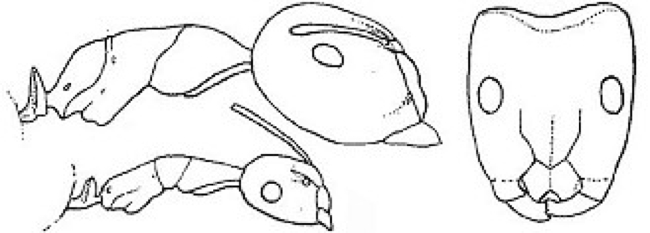 TL major 9.0 mm, minor
5.0 mm; cf havilandi but
darker, wider head, more convex propodeum; head massive, anterior
margin of clypeus widely and angularly excised; few erect hairs,
notably on dorsum of gaster with two rows, one mid-length and one
apical, on each segment; mandibles shiny strongly striato-punctate,
head dull and strongly reticulo-punctate to middle of eyes, posteriorly
microscopically reticulate and glossy; head black, alitrunk pale brown,
gaster black (anterior of first tergite paler), appendages ferruginous TL major 9.0 mm, minor
5.0 mm; cf havilandi but
darker, wider head, more convex propodeum; head massive, anterior
margin of clypeus widely and angularly excised; few erect hairs,
notably on dorsum of gaster with two rows, one mid-length and one
apical, on each segment; mandibles shiny strongly striato-punctate,
head dull and strongly reticulo-punctate to middle of eyes, posteriorly
microscopically reticulate and glossy; head black, alitrunk pale brown,
gaster black (anterior of first tergite paler), appendages ferruginous |
. |
| . |  |
South Africa - transvaalensis |
| -- | 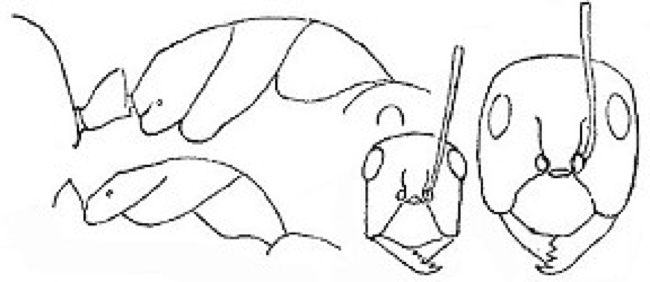 TL
major 13 mm, media 11 mm, minor 7.5 mm; scape surpasses occiput by 0.25
of own length; mandibles finely striate; clypeus with alitrunk, occiput
and tibiae yellow rust, rest ferruginous, gaster black posterior of
segments bordered with yellow TL
major 13 mm, media 11 mm, minor 7.5 mm; scape surpasses occiput by 0.25
of own length; mandibles finely striate; clypeus with alitrunk, occiput
and tibiae yellow rust, rest ferruginous, gaster black posterior of
segments bordered with yellow |
. |
| . |  Major Major |
. |
| . |  Minor Minor |
Namibia - belligerus |
| 6 |  TL major/media
7.5-8.2 mm; with unique obtuse angular lobe
at base of scape; scape surpassing occiput by one-third it own length;
head subrectangular, eyes placed behind midpoint of head; propodeal
dorsum very oblique, twice as long as declivity and merging gradually
into latter; generally brownish or reddish-ochreous, only moderately
shining; mandibles strongly striato-punctate TL major/media
7.5-8.2 mm; with unique obtuse angular lobe
at base of scape; scape surpassing occiput by one-third it own length;
head subrectangular, eyes placed behind midpoint of head; propodeal
dorsum very oblique, twice as long as declivity and merging gradually
into latter; generally brownish or reddish-ochreous, only moderately
shining; mandibles strongly striato-punctate |
|
| . |  Major Major |
. |
 Minor Minor |
Namibia, Botswana & South Africa - cuneiscapus | |
| -- | Scape without angular basal lobe | 7 |
| 7 | 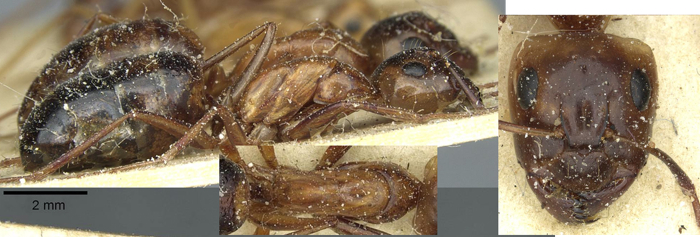 TL major 11.5-12.0 mm; cf belligerus;
head trapezoidal HL 2.5, posterior HW 2.2, anterior HW 2.0; scape
surpassing occiput by about 0.25 own length; alitrunk high and short,
propodeum regularly convex; petiole scale higher; clear yellow brown
with chestnut areas; very finely shagreened smooth and shiny; fine
short hairs mainly on gaster (minor worker) TL major 11.5-12.0 mm; cf belligerus;
head trapezoidal HL 2.5, posterior HW 2.2, anterior HW 2.0; scape
surpassing occiput by about 0.25 own length; alitrunk high and short,
propodeum regularly convex; petiole scale higher; clear yellow brown
with chestnut areas; very finely shagreened smooth and shiny; fine
short hairs mainly on gaster (minor worker) |
. |
| . |  Minor Minor
|
Zimbabwe - debellator |
| -- |  TL major 9 mm.
media/minor 4.5-5 mm; head elongated HL 2.8
HW 2.3 SL 1.9; truncate posteriorly, parallel sided, clypeus produced
anteriorlry into a narrow porrect (beak-like) lobe with tridentate
apex; propodeum arcuate; few erect hairs and little pubescence; dull,
gaster nitidulous; sordid testaceous, gaster darker TL major 9 mm.
media/minor 4.5-5 mm; head elongated HL 2.8
HW 2.3 SL 1.9; truncate posteriorly, parallel sided, clypeus produced
anteriorlry into a narrow porrect (beak-like) lobe with tridentate
apex; propodeum arcuate; few erect hairs and little pubescence; dull,
gaster nitidulous; sordid testaceous, gaster darker |
. |
| . | 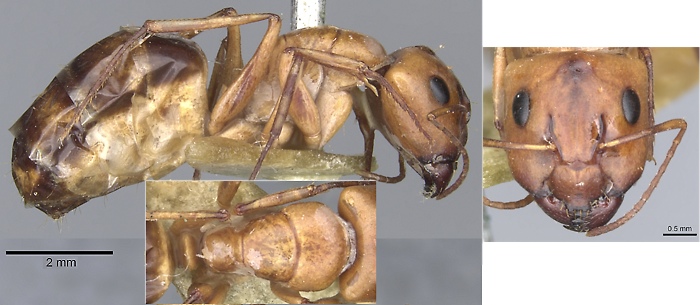 Major Major |
. |
| . |  Minor Minor |
Namibia, Zimbabwe & South Africa - nasutus |
| -- | 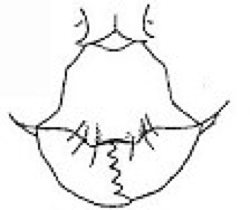 TL
major 5.0-6.5 mm; head subquadrate only narrowing being slight at
anterior; clypeus with transverse emargination and lateral broad
truncate teeth; propodeum dorsum joins declivity in a widely rounded
angle; petiole a thin ovate scale; few erect hairs; microscopically
rugulose on alitrunk and gaster, head more coarsely rugulose, shining;
dark reddish ochreous, lateral alitrunk brownish, gaster brown TL
major 5.0-6.5 mm; head subquadrate only narrowing being slight at
anterior; clypeus with transverse emargination and lateral broad
truncate teeth; propodeum dorsum joins declivity in a widely rounded
angle; petiole a thin ovate scale; few erect hairs; microscopically
rugulose on alitrunk and gaster, head more coarsely rugulose, shining;
dark reddish ochreous, lateral alitrunk brownish, gaster brown |
. |
| . |  |
South Africa - emarginatus |
| Genus page |
© 2007, 2011, 2013, 2014, 2018 - Brian Taylor CBiol FRSB FRES 11, Grazingfield, Wilford, Nottingham, NG11 7FN, U.K. |
href="myrmespera.htm"